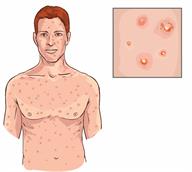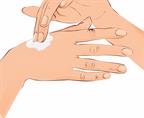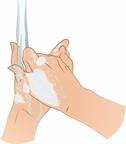Mpox Infection: What to Know

Mpox is an infection that causes flu-like symptoms and a rash that looks like pimples. The rash turns into blisters and then scabs.
Mpox is contagious at the time the symptoms start. This means it can spread from person to person. It's contagious until the rash is gone and a new layer of skin has formed. It may take 2–4 weeks to recover from mpox.
What are the causes?
Mpox is caused by the mpox virus. You may get it by:
Having direct contact with body fluids or the rash or scabs of an infected person.
Breathing in droplets from an infected person.
Touching something that's been used by a person with the virus, such as clothes, bedding, or towels.
Having contact with an infected animal.
The virus can also be passed to an unborn baby during pregnancy.
What increases the risk?
You may be more likely to get mpox if:
You take care of a person with mpox.
You live in or travel to an area with cases of mpox.
You have sex with more than one person.
You're a male who has sex with males.
What are the signs or symptoms?
Symptoms of mpox may start within 3 weeks of being exposed to the virus. Symptoms can range from mild to severe. They may include:
Rash on the face, mouth, chest, genitals, anus, hands, or feet. The rash may hurt or itch.
Fever or chills.
Sore throat or cough.
Stuffy nose.
Headache.
Muscle aches.
Swollen lymph nodes.
Other symptoms may include:
Most people with mpox get the rash. Some may only have the rash and no other symptoms.
How is this diagnosed?
Mpox may be diagnosed based on:
How is this treated?
Treatment may include:
Serious symptoms may be treated in the hospital.
Follow these instructions at home:
Medicines

-
Take your medicines only as told.
-
Use an anti-itch cream or numbing cream on the rash as told.
-
If you were given an antiviral medicine, take it only as told. Do not stop using it even if you start to feel better.
Relieving itching and discomfort
-
Apply cold, wet cloths to the rash or blisters as told.
-
Do not bathe in hot water.
-
Take cool baths for itchy skin. Try adding baking soda, Epsom salts, or dry oatmeal to the water.
- If you have blisters in your mouth:
Avoid foods and drinks that are spicy, salty, or acidic. Soft, bland, and cold foods and drinks are easiest to swallow.
Swish and gargle with salt water and then spit it out. To make salt water, add a half to a whole spoonful of salt to a glass of warm water. Mix well.
Blister and rash care

-
Wear loose-fitting clothing to keep it from rubbing against the rash.
-
Wash your hands with soap and water for at least 20 seconds after touching the rash. If you can't use soap and water, use hand sanitizer.
-
Keep your rash and blisters clean. Wash the area with mild soap and cool water as told.
- Check your rash every day for signs of infection. Check for:
More redness, swelling, or pain.
More fluid or blood coming from the blisters.
Warmth.
Pus or a bad smell.
-
Do not scratch your rash or pick at your blisters. To help prevent scratching:
General instructions
- If you're sick, stay home except to get medical care.
- To help prevent spreading the rash:
-
Drink more fluids as told.
-
Disinfect objects and surfaces that you touch a lot.
-
Ask what things are safe for you to do at home. Ask when you can go back to work or school.
-
Ask your provider when it's safe for you to be around others.
How is this prevented?
To protect yourself:
-
Stay away from people who are sick.
-
Do not touch a rash on someone else's skin.
-
Avoid crowded indoor spaces. Follow guidance from your country and local health authorities.
-
Talk to your provider about your risk and whether you should get the mpox vaccine.
-
Avoid contact with wild animals in areas where mpox is more common.
To protect others:
-
Call your provider before you go for medical care.
-
Wear a well-fitting face mask that covers your nose and mouth around others.
-
Cough or sneeze into a tissue or your sleeve or elbow. Do not cough or sneeze into your hand or into the air.
-
Stay away from other members of your household. Let others care for children and pets.
- If you can:
Stay home.
Stay in your own room, away from others.
Use a separate bathroom.
If you must be around people, cover your rash with a loose bandage or wear long sleeves and pants.
-
Do not use public transport, if possible.
-
Make sure you and everyone in your household washes their hands well and often.
To learn more, go to:
- Centers for Disease Control and Prevention at cdc.gov.
Click "Search" and type "mpox."
Find the link you need.
- World Health Organization at who.int.
Click "Search" and type "mpox."
Find the link you need.
Contact a health care provider if:
These symptoms may be an emergency. Call 911 right away.
This information is not intended to replace advice given to you by your health care provider. Make sure you discuss any questions you have with your health care provider.


